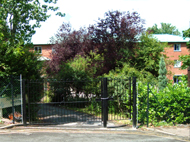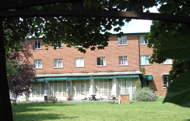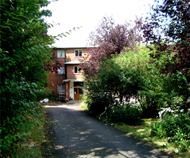Henderson
Hospital
2 Homeland Drive, Sutton, Surrey
SM2 5LT
Medical
dates:
Medical
character:
Specialist
Following WW2 a Social
Rehabilitation Unit was established on a corner of the Belmont Hospital
site for soldiers suffering from war neuroses
(paralysis, tremors, depression or recurring nightmares - what we now
call post-traumatic stress disorder).
The unit progressed to treating adults who had experienced extreme neglect or abuse in childhood, to help them overcome their difficulties.
In 1959 it was renamed the Henderson Hospital, after the Scottish psychiatrist Professor Sir David Henderson (1884-1965), author of Psychopathic States, a book which became an instant classic on the subject.
It was the first British hospital to develop a patient-orientated approach to the treatment of psychopathic disorders. Its ethos was that those who had experienced similar traumas would be best placed to offer support to their peers - a 'therapeutic community'.
Adult patients suffering from personality disorder would be resident for up to a year. Pioneering treatment consisted of combined group-based psychotherapy and sociotherapy as alternatives to medication. Art and music therapy, psychodrama and work groups for cooking, gardening and maintenance took place regularly during the week. Patients outnumbered staff by 3 to 1 and were given a major say in who could be admitted.
In 1965 the Hospital had 100 beds, of which 68 were staffed. The weekly cost of an in-patient was £29 9s 8d (£29.48), which rose dramatically in 1966 to £47 12s 8d (£47.63).
In 1970 the weekly cost of an in-patient was £48.54 and, in 1971, £56.35.
Until 2005 the Hospital had received national funding from the National Specialist Commissioning Advisory Group (NSCAG), part of the Department of Health. In 2006 the NSCAG passed the task of commissioning the Henderson Hospital to a consortium of 128 PCTs in South East England, all of which could refer patients to the Hospital. Each PCT was required to pay the Hospital £23,000 annually, regardless of the number of patients it referred there (or not). However, the consortium was unable to prevent PCTs from withdrawing funding for the 2007-2008 period if they so chose. As most PCTs were under financial pressures of their own, about two-thirds of the consortium opted to pay on a cost-per-case basis. Thus, the contract money for the Hospital dried up and the 29-bedded Henderson Hospital became financially unviable as referrals dwindled. By the beginning of 2008 only five patients were resident.
The successful Henderson Hospital - one of only two such specialist hospitals in the country to treat personality disorders effectively and humanely - closed 'temporarily' in April 2008, a victim of the new, complicated, and perhaps self-defeating, government funding policy.
One of the patients was discharged as cured and the remaining four transferred to the Cassel Hospital in Richmond.
Present status (August 2008)
The main gate is closed and padlocked. The building remains vacant while debate continues about the Hospital re-opening here or elsewhere.
The unit progressed to treating adults who had experienced extreme neglect or abuse in childhood, to help them overcome their difficulties.
In 1959 it was renamed the Henderson Hospital, after the Scottish psychiatrist Professor Sir David Henderson (1884-1965), author of Psychopathic States, a book which became an instant classic on the subject.
It was the first British hospital to develop a patient-orientated approach to the treatment of psychopathic disorders. Its ethos was that those who had experienced similar traumas would be best placed to offer support to their peers - a 'therapeutic community'.
Adult patients suffering from personality disorder would be resident for up to a year. Pioneering treatment consisted of combined group-based psychotherapy and sociotherapy as alternatives to medication. Art and music therapy, psychodrama and work groups for cooking, gardening and maintenance took place regularly during the week. Patients outnumbered staff by 3 to 1 and were given a major say in who could be admitted.
In 1965 the Hospital had 100 beds, of which 68 were staffed. The weekly cost of an in-patient was £29 9s 8d (£29.48), which rose dramatically in 1966 to £47 12s 8d (£47.63).
In 1970 the weekly cost of an in-patient was £48.54 and, in 1971, £56.35.
Until 2005 the Hospital had received national funding from the National Specialist Commissioning Advisory Group (NSCAG), part of the Department of Health. In 2006 the NSCAG passed the task of commissioning the Henderson Hospital to a consortium of 128 PCTs in South East England, all of which could refer patients to the Hospital. Each PCT was required to pay the Hospital £23,000 annually, regardless of the number of patients it referred there (or not). However, the consortium was unable to prevent PCTs from withdrawing funding for the 2007-2008 period if they so chose. As most PCTs were under financial pressures of their own, about two-thirds of the consortium opted to pay on a cost-per-case basis. Thus, the contract money for the Hospital dried up and the 29-bedded Henderson Hospital became financially unviable as referrals dwindled. By the beginning of 2008 only five patients were resident.
The successful Henderson Hospital - one of only two such specialist hospitals in the country to treat personality disorders effectively and humanely - closed 'temporarily' in April 2008, a victim of the new, complicated, and perhaps self-defeating, government funding policy.
One of the patients was discharged as cured and the remaining four transferred to the Cassel Hospital in Richmond.
Present status (August 2008)
The main gate is closed and padlocked. The building remains vacant while debate continues about the Hospital re-opening here or elsewhere.

The gates of the Hospital remain chained and padlocked


The driveway leading to the Hospital
The future of the Hospital is still
uncertain
Dolan B 1992 One year after the NHS Bill: the extra-contractural referral system and Henderson Hospital. Psychiatric Bulletin 16, 745-747.
Henderson DK 1939 Psychopathic States. London, Chapman & Hall.
http://hansard.millbanksystems.com
http://news.bbc.co.uk
www.bsrca.com
www.communitycare.co.uk
www.politics.co.uk
www.ramas.co.uk
www.swlstg-tr.nhs.uk
www.tunbridgewells.gov.uk
Return to home page